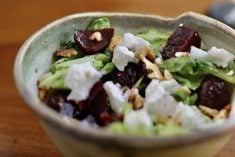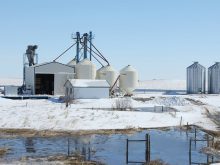I love to be outside and in the garden. When we lived on the farm, a garden was a vegetable garden. It seemed strange at first to read and hear people talk about flowers and other plants in their landscaped gardens, not potatoes and carrots. Gardening magazines and garden shows usually take us to landscaped yards and not to vegetable gardens.
However, there seems to be a growing interest in vegetable gardens and in growing the food we eat. It could be in pots on top of highrise buildings, in backyard garden plots or in community gardens.
Read Also

Communication key to bridging generation gap
Each generation is shaped by the predominant forces at play during their formative years. Acknowledging these influences can improve communication among the generations.
The David Suzuki Foundation says that the basic North American meal could travel 2,400 km (about 1,500 miles) to get to our dinner table and describes transported food as tired travellers.
Some of the advantages of growing our own fresh food or buying locally include reducing the transport costs and greenhouse gases that come with transporting food and helping conserve farmlands and wildlife habitats.
Growing a garden and being outside produces psychological benefits. Just looking at trees and plants reduces stress, lowers blood pressure and helps muscle tension.
The Alberta Centre for Active Living recommends gardening as a good physical activity for endurance, flexibility and strength. It is Canada’s second most popular physical activity after walking.
If you do not have sufficient space, a community garden is an option. Some city parks and health or other community organizations may run a community garden. Many of our small towns have empty lots that could be used.
Some gardeners do the work themselves while others share the work and harvest.
Community gardens can break down the barriers of isolation and create a sense of neighbourhood among residents, while creating a green space.
Fresh asparagus with orange-lemon sauce
I tried this recipe on my fresh asparagus that is popping out of the ground. Quick to make, the sauce adds zip to the asparagus.
1 bunch asparagus, about 2 lbs. 1 kg
2 tablespoons butter 25 mL
1/4 cup orange juice 60 mL
4 teaspoons lemon juice 20 mL
1/2 teaspoon grated lemon rind 2 mL
1/2 teaspoon grated orange rind 2 mL
Wash and cook asparagus until tender. Drain.
Melt butter and stir in remaining ingredients. Heat to serving temperature, stirring occasionally. Serve over cooked asparagus. Garnish with lemon slices, if desired.
Serves six.
Source: Adapted from Eat Your Heart Out, by Sirrine, Leavitt and Kiester, 1978.
ATVs: if it’s too big, get off
Did you know that the all-terrain vehicle (ATV) was developed in Japan for people in isolated mountainous areas to get to town? The Japanese manufacturers realized that ATVs could also be sold in the Americas.
ATVs first appeared in the United States and Canada in the early 1970s, promoted and sold as recreational vehicles providing thrills for riders.
They also help ranchers, loggers and hunters move through areas not accessible by truck.
But ATV use is not without its challenges, including safety concerns for riders and the impact on the environment.
They are noisy, use fossil fuels and can destroy nature if riders do not stay on designated paths. They are sometimes involved in serious accidents.
Almost all ATV accidents can be preventedif the ATV Safety Institute golden rules for summer safety are followed:
- Always wear a helmet and other protective gear.
- Never ride on public roads because another vehicle could hit you.
- Never ride under the influence of alcohol or drugs.
- Never carry a passenger on a single-rider vehicle.
- Ride an ATV that is right for your age. If it’s too big, get off.
- Supervise young riders because ATVs are not toys.
- Ride only on designated trails and at a safe speed.
- Take an ATV rider course.
Arctic Cat, one ATV manufacturer, writes: “One of the biggest challenges we face in this industry is making it clear to parents that they cannot put their children on an adult-sized machine. Until they reach a certain size and maturity level, kids just aren’t capable of handling the size and power.”
Businesses that sell ATVs are a good source of information on rider courses in your area but it is also important to follow manufacturer’s instructions.
Contact the Canada Safety Council at
1020 Thomas Spratt Place, Ottawa, Ont,
K1G 5L5. Phone: 613-739-1535 or visit www.safety-council.org/training/ATV/atvcpde.htm.
Cooked potatoes turning dark
Dear TEAM:
Summer is coming and that means more salads. My family loves potato salad. Why do the cooked potatoes so often turn gray? It makes an unappetizing looking salad.
– V.R. Rosenort, Man.
Dear V.R:
The Prince Edward Island Potatoes Consumer Centre says there are two possibilities for potatoes darkening after cooking.
1) It may be caused by a natural reaction with the iron and other compounds in the potato. To prevent this, add a little lemon juice or vinegar to the cooking water. The Potato Growers of Alberta suggests adding the dressing while the potatoes are warm.
2) When potatoes are stored at refrigerator temperatures below 4.4 C, the starch in the potato changes to sugar. When cooked, this sugar caramelizes or darkens. Store potatoes in a cool 7.2-10 C location.
The darkening does not affect flavour or nutritional value, just the appearance.
PGA offers these tips:
Red or yellow skinned potatoes hold their shape well during cooking and are best for potato salad.
Do not store potatoes near garlic or onions because both emit gases that will speed up deterioration of the other.
Store potatoes in a dark location. A compound in potatoes called solanin is formed if potatoes are exposed to sunlight or manmade light. It gives potatoes a green tinge that is bitter and can cause illness. If there is green on the potato, peel it all away.
Potatoes need ventilation. Store in card-board boxes or burlap bags, not airtight plastic bags.
When storing potatoes, apples are a good companion as they keep the potatoes from sprouting.
Big league casserole
I clipped this recipe from a Kraft magazine and occasionally make it. It’s a good dish for leftover cooked potatoes.
1/2 pound Velveeta cheese 226 g
1/2 cup milk 125 mL
1/2 cup chopped green pepper 125 mL
1 tablespoon oil or butter 15 mL
8 frankfurters
4 cups diced cooked potatoes 1 L
salt and pepper seasoning
Heat Velveeta cheese and milk in a saucepan. Stir until smooth.
Cook green pepper in oil or butter until tender. Cut frankfurters into chunks, diagonally. Combine green pepper, frankfurters and potatoes. Season with salt and pepper. Place in a casserole dish. Cover with hot Velveeta sauce.
Bake 30 minutes or until hot at 350 F (180 C.) Serves approximately four.
Alma Copeland is a home economist from Elrose, Sask., and one of four columnists comprising Team Resources. Send correspondence in care of this newspaper, Box 2500, Saskatoon, Sask., S7K 2C4 or contact them at team@producer.com.














